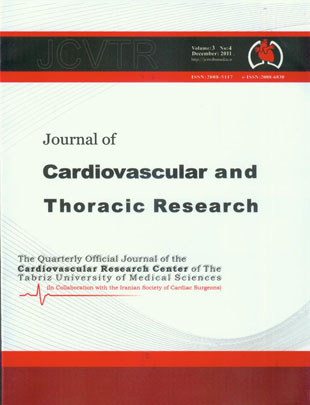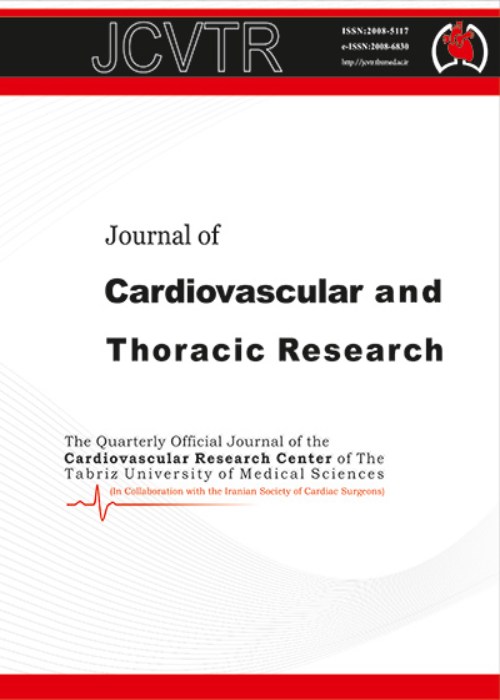فهرست مطالب

Journal of Cardiovascular and Thoracic Research
Volume:3 Issue: 4, Dec 2011
- تاریخ انتشار: 1391/04/06
- تعداد عناوین: 7
-
-
Page 103IntroductionThe aim of this study was to determine incidence of cardiovascular disease (CVD) risk factors [hypertension (HTN), obesity, Dyslipidemia (DLP), diabetes mellitus (DM) and smoking] in Oskoo.MethodsThis study was planned according to WHO pro-tocol “WHO CVD-risk management package for low and medium-resource settings” and named “East Azerbaijan healthy heart program”. The pilot study of this program was done in Oskoo in 2007-2009. In this study, demographic data and CVD risk factors of 37,329 adults aged≥30 years old living in Oskoo were collected. In addition, blood samples of 17,388 adults≥40 years old were taken (free of charge) for assessment of serum glucose and lipid profile.ResultsThe study covered 93.52% of Oskoo town population aged≥30 years old. We studied 18637 male (M) (91.50% coverage) and 18692 female (F) (95.52% coverage) participants. The incidence of HTN [SBP≥140 & DBP≥90 mmHg] was 16.25% (M:15.08%, F:17.29%), pre-hypertension [SBP=120-139 & DBP=80-89 mmHg] =37.78% (M:41.38%, F:34.18%), DM [fast blood glucose (FBS)≥126mg/dl] was 7.45% (M:6.35%, F:8.54%), smoking was 9.40% (M:17.00%, F:1.57%), hypercholesterolemia (>200mg/dl) was 47.64% (M:42.46%, F:52.81%) and obesity [body mass index (BMI) ≥27] was 50.47% (M:38.79%, F:62.09%).ConclusionConsidering high incidence of CVD risk factors (except smoking) in Oskoo adults ≥30 years, it is recommended that this pilot study expanded to all of East Azerbaijan. Free of charge taking blood samples from people ≥ 40 years to evaluate lipid profile and glucose levels is worthy to early detecting the prevalent DM or DLP in this target population.Keywords: Cardiovascular Disease Risk Factor, Prevalence, Community, based Study
-
Page 111IntroductionPeripheral arterial disease is associated with an excessive risk for cardi-ovascular events and mortality. Peripheral arterial disease is usually measured with ankle brachial index (ABI). It is previously shown that the ABI would reflect LV systolic func-tion, as well as atherosclerosis; however, these results are not shown in non-diabetic indi-viduals. In this study, we aim to evaluate this relation in non-diabetic individu-als.MethodsIn a prospective study, 73 non-diabetic individuals (38.4% male with mean age of 59.20±14.42 years) referred for ABI determination who had had the left ventricular ejection fraction determined using trans-thoracic echocardiography were studied. Partici-pants were compared in normal and low ABI groups.ResultsThe mean left ventricular ejection fraction (LVEF) was 52.34±7.69, mean ankle brachial index for the right leg was 1.08±0.13, and the mean ankle brachial index for the left leg was 1.07±0.12. Low ABI incidence was 12.32%. Individuals with low ABI significantly were older (p<0.001) and had lower left ventricular ejection fraction (p<0.001). ABI had significantly inverse corre-lation with LVEF (r=-0.53, p<0.001) and positive correlation with age (r=0.43, p<0.001). The ABI correlated inversely with LVEF in the patients with (r =-0.52, p=0.008) and without (r=-0.55, p<0.001) IHD.ConclusionResults showed that ankle brachial index would be influenced by left ventricular ejection fraction in non-diabetics and to evaluate and monitor cardiovascular risk in patients these should be considered together.Keywords: Diabetes Left Ventricular Ejection Frac, tion, Atherosclerosis, Ankle Brachial Index
-
Page 117IntroductionDrug-eluting stents (DES) have significantly decreased the need for repeat coronary revascularization but concerns remain regarding the safety of first and second generation DES. We compared the safety and efficacy of a biolimus-eluting stent (with biodegradable polymer) with an everolimus-eluting stent (with durable polymer) one.MethodsWe performed a randomized trial to compare the two types of stents. Two hundred patients undergoing PCI for de novo lesions were randomly assigned 1:1 to treat-ment with either biolimus-eluting (BioMatrix) or everolimus -eluting (Xience V) stent. The primary endpoint was a composite of cardiac death, myocardial infarction, and clinically driven target vessel revascularization within 12 months.ResultsDemographics, clinical, and lesion characteristic were comparable between two groups. The 30-day major adverse cardiac event (MACE) rate was 2% in BioMatrix group versus 0% in Xience group (p > 0.05). After 12 months, the rates of cardiac death (0% in both groups), MI (2% versus 0%, p=0.49) and clinically –driven target vessel revascularization (0% in both groups) were similar for BioMatrix and Xience. No stent thrombosis was reported at 1, 6, 9 or 12 months after intervention in either group.ConclusionBES (Biolimus-eluting stent) with biodegradable polymer and EES (Everolimus-eluting stent) with durable polymer appear similar with respect to MACE and stent thrombosis in this patient population. Many studies with longer follow up are needed to define better the role of BES with bio-degradable polymer in treatment of coronary artery lesions.Keywords: Biolimus, Eluting Stent, Everolimus, Eluting Stent, Biodegradable Polymer, Coronary Artery Disease, Revascularization
-
Page 121IntroductionHuman cord blood-derived stem cells are a rich source of stem cells as well as precursors. With regard to the researchers have focused on the therapeutic potential of stem cell in the neurological disease such as stroke, the aim of this study was the investiga-tion of the therapeutic effects of human cord blood-derived stem cells in cerebral ischemia on rat.MethodsThis study was carried out on young rats. Firstly, to create a laboratory model of ischemic stroke, carotid artery of animals was occluded for 30 minutes. Then, umbilical cord blood cells were isolated and labeled using bromodeoxyuridine and 2×105 cells were injected into the experimental group via the tail vein. Rats with hypoxic condi-tions were used as a sham group. A group of animals did not receive any injection or sur-geries were used as a control.ResultsObtained results were evaluated based on behavior-al responses and immunohistochemistry, with emphasis on areas of putamen and caudate nucleus in the control, sham and experimental groups. Our results indicated that behavioral recovery was observed in the experimental group compared to the either the sham or the control group. However, histological studies demonstrated a low percent of tissue injury in the experimental group in comparison with the sham group.ConclusionsStem cell transplantation is beneficial for the brain tissue reparation after hypoxic ischemic cell death.Keywords: Stem Cell, Stroke, Brain Damage, Umbilical Cord Blood
-
Page 127IntroductionReperfusion injury is one of the most common phenomena associated with coronary artery bypass graft (CABG). The mechanism of ischemia and reperfusion injury is not known precisely, but may be free radicals and other activated oxygen metabolites have an important role in tissue damage following reperfusion injury. This study was to evaluation of citrate solution effects on oxidative stress and cardiac function and Cardiac enzymes in patient's candidate to CABG.MethodsIn Double blind clinical trial study in Tabriz University of medical science, 50 patients candidate to CABG randomly divided in two groups and matched together according to sex, age and NYHA class. In intervention group after surgery and before the opening of the aortic clamping solution warm blood containing citrate phosphate dextrose (CPD; 3cc/100cc), value (100cc/min/m2BSA) for three minutes was administered. In control group, only pure blood administered. Oxidative stress markers measured in five stages and cardiac enzymes measured in three stages of surgery.ResultsMean age 62.3±9.1 years including 30(60%) men and 20(40%) women. Ejection fractions between two groups were not significant before and after treatment. Administration of CPD was not significant effects on cardiac enzyme. Measurement of oxidative stress in different time were not different in Malonil Di Aldehid, superoxide dismutase and GPx but total antioxidant status were improved after intervention in compared with control group (p<0.001).ConclusionResults showed that CPD were positive effects of increasing in total antioxidant status after CABG, but in reduction of other oxidative markers were unlabeled.Keywords: Oxidative Stress, Coronary Artery Bypass Graft Reperfusion Injury
-
Page 133Saccular type of thoracic aortic aneurysm is a rarely seen phenomenon. Here, we present a case of saccular-type aortic aneurysm admitted to coronary care unit with a diagnosis of acute coronary syndrome. A 63-year-old woman presented to our clinic with chest pain lasting for 2-3 hours. Because her chest pain persisted despite intensive medical treatment, she underwent coronary angiography. Coronary arteries appeared normal but a saccular type aneurysm of ascending aorta was detected on aortography. The patient underwent urgent surgery. The aneurysmal segment was resected and tube graft inserted. The patient was discharged without any postoperative complication.Keywords: Acute Coroner Syndrome, Saccular Aortic Aneurysm, Dissection
-
Page 137IntroductionNasal ala pressure sores are among complications of nasogastric tube in Pediatric Intensive Care Unit (PICU). The severity of the injury is usually minor and easily ignored. However, the complication could be easily avoided. This is a case of nasal ala sore after the placement of nasal enteral tube in a pediatric intensive care unit in our center.Case PresentationA 5-month-old female with pulmonary hypertension secondary to bronchiectasis with nasal ala pressure sore were reported. She was hospitalized in pediatric intensive care unit at Tabriz Children Hospital in 2010.After 53 days of PICU hospitalization she had nasal ala sore.ConclusionWe know that nasal ala pressure sores could easily be avoided when preventive procedures were performed during nasogastric tube insertion.Keywords: Nasogastric Tubes, Children, Nasal Ala Pressure Sore


